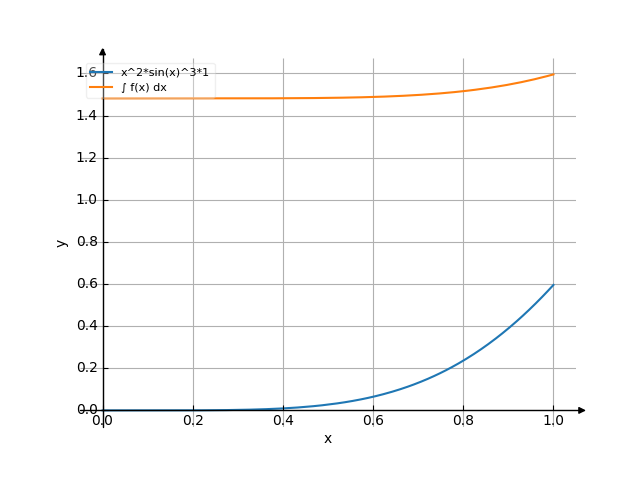Integral of x^2sinx^3dx dx
The solution
1 / | | 2 3 | x *sin (x)*1 dx | / 0
Integral(x^2*sin(x)^3*1, (x, 0, 1))
-
Use integration by parts:
Let and let .
Then .
To find :
-
Rewrite the integrand:
-
There are multiple ways to do this integral.
Method #1
-
Let .
Then let and substitute :
-
Integrate term-by-term:
-
The integral of is when :
-
The integral of a constant is the constant times the variable of integration:
The result is:
-
Now substitute back in:
-
Method #2
-
Rewrite the integrand:
-
Integrate term-by-term:
-
The integral of a constant times a function is the constant times the integral of the function:
-
Let .
Then let and substitute :
-
The integral of a constant times a function is the constant times the integral of the function:
-
The integral of is when :
So, the result is:
-
Now substitute back in:
-
So, the result is:
-
-
The integral of sine is negative cosine:
The result is:
-
Method #3
-
Rewrite the integrand:
-
Integrate term-by-term:
-
The integral of a constant times a function is the constant times the integral of the function:
-
Let .
Then let and substitute :
-
The integral of a constant times a function is the constant times the integral of the function:
-
The integral of is when :
So, the result is:
-
Now substitute back in:
-
So, the result is:
-
-
The integral of sine is negative cosine:
The result is:
-
-
-
Now evaluate the sub-integral.
Use integration by parts:
Let and let .
Then .
To find :
-
Integrate term-by-term:
-
Rewrite the integrand:
-
Let .
Then let and substitute :
-
Integrate term-by-term:
-
The integral of a constant is the constant times the variable of integration:
-
The integral of a constant times a function is the constant times the integral of the function:
-
The integral of is when :
So, the result is:
-
The result is:
-
Now substitute back in:
-
-
-
The integral of a constant times a function is the constant times the integral of the function:
-
The integral of cosine is sine:
So, the result is:
-
The result is:
Now evaluate the sub-integral.
Integrate term-by-term:
-
The integral of a constant times a function is the constant times the integral of the function:
-
Rewrite the integrand:
-
Let .
Then let and substitute :
-
Integrate term-by-term:
-
The integral of is when :
-
The integral of a constant is the constant times the variable of integration:
The result is:
-
Now substitute back in:
-
-
So, the result is:
-
The integral of a constant times a function is the constant times the integral of the function:
-
The integral of sine is negative cosine:
So, the result is:
-
The result is:
Now simplify:
Add the constant of integration:
The answer is:
/ 3 \ / | sin (x)| | 3 / 3 \ 2*x*|-2*sin(x) - -------| | 2 3 2*cos (x) 14*cos(x) 2 | cos (x)| \ 3 / | x *sin (x)*1 dx = C - --------- + --------- + x *|-cos(x) + -------| - ------------------------- | 27 9 \ 3 / 3 /
3 3 2 2 40 14*sin (1) 22*cos (1) 4*cos (1)*sin(1) 5*sin (1)*cos(1) - -- + ---------- + ---------- + ---------------- + ---------------- 27 9 27 3 9
=
3 3 2 2 40 14*sin (1) 22*cos (1) 4*cos (1)*sin(1) 5*sin (1)*cos(1) - -- + ---------- + ---------- + ---------------- + ---------------- 27 9 27 3 9

Use the examples entering the upper and lower limits of integration.

![Find the integral of y = f(x) = x²sinx³dx (x squared sinus of x cubed dx) - with detailed solution [THERE'S THE ANSWER!] x^2sinx^3dx](/media/krcore-image-pods/176/hash/indefinite/3/48/1d823d211cea98cce9318b0fdcec4.png)
 Integral of xexp(-x)
Integral of xexp(-x)
 Integral of x^2sinx^3dx
Integral of x^2sinx^3dx